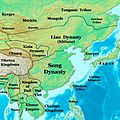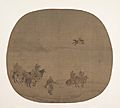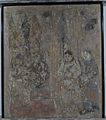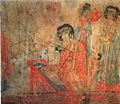Khitan people facts for kids

Khitans
|
|
| Regions with significant populations | |
|---|---|
| northeastern Asia | |
| Languages | |
| Khitan language | |
| Religion | |
| Animist Taoism Buddhism Islam |
|
| Related ethnic groups | |
| Mongol people |
The Khitan (say: KEE-tan) people were a group of nomadic people who lived in northeastern Asia. They were active from the fourth century onwards. Their homeland was in areas that are now Mongolia, northeastern China, and the Russian Far East.
The Khitans spoke the Khitan language. This language is quite similar to the Mongolic languages spoken by the Mongols.
Contents
Who Were the Khitans?
The Khitans were a strong and important group of people. They were known for their skills in horse riding and hunting. Being nomadic meant they often moved from place to place. They followed their herds and found new pastures for their animals.
Where Did They Live?
The Khitan people lived in a large area of northeastern Asia. This region included parts of modern-day Mongolia and China. It also stretched into what is now the Russian Far East. This vast land offered them space for their nomadic lifestyle.
What Language Did They Speak?
The Khitans had their own language called Khitan language. They also developed two writing systems for it. These were the Khitan large script and the Khitan small script. These scripts helped them record their history and culture. Their language is related to the Mongolic language family.
The Powerful Liao Dynasty
Around the year 907 AD, the Khitans became very powerful. They established a large empire called the Liao dynasty. This dynasty ruled over a vast territory in East Asia for more than 200 years. The Liao dynasty was a major power in the region. It often interacted with other empires, like the Song dynasty in China.
How They Ruled
The Liao dynasty was unique because it ruled over both nomadic and settled people. The Khitans kept their nomadic traditions. But they also adopted some ways of governing from the Chinese. They had a dual system of government. One part managed the Khitan people and their traditions. The other part managed the settled Chinese population.
Daily Life and Culture
Life for the Khitans involved a mix of nomadic and settled activities. They were excellent horsemen and hunters. Falconry, which is hunting with trained falcons, was a popular activity. Their art often showed scenes of hunting and daily life.
Art and Architecture
The Khitans created beautiful art, including paintings and murals. These artworks often decorated their tombs. They also built impressive structures. A famous example is the Pagoda of Fogong Temple. This tall wooden pagoda was built during the Liao dynasty. It shows their skill in architecture.
Their Beliefs
The Khitan people had several religious beliefs. Many followed Animism, which means they believed spirits lived in nature. They also adopted Taoism and Buddhism. Later, some Khitans also practiced Islam. This mix of religions shows how their culture changed over time.
What Happened to the Khitans?
The Liao dynasty eventually fell in 1125 AD. This happened because of attacks from other groups, like the Jurchens. After their empire fell, some Khitans moved west. They formed a new empire called the Qara Khitai (or Western Liao dynasty). This empire lasted for about 90 years. Over time, many Khitans blended into other groups, like the Mongols and Chinese. However, their legacy as a powerful nomadic people remains important in history.
Images for kids
-
Liao dynasty tomb relief of Khitans and their baggage cart
-
Liao dynasty in 1025
-
The Liao dynasty in 1111 AD.
-
The Qara Khitai empire in 1169 at its greatest extent
-
The Pagoda of Fogong Temple, built in 1056.
-
Liao dynasty funerary mask and crown
-
Ming dynasty depiction of a Khitan
Related pages
See also
 In Spanish: Kitán para niños
In Spanish: Kitán para niños






























